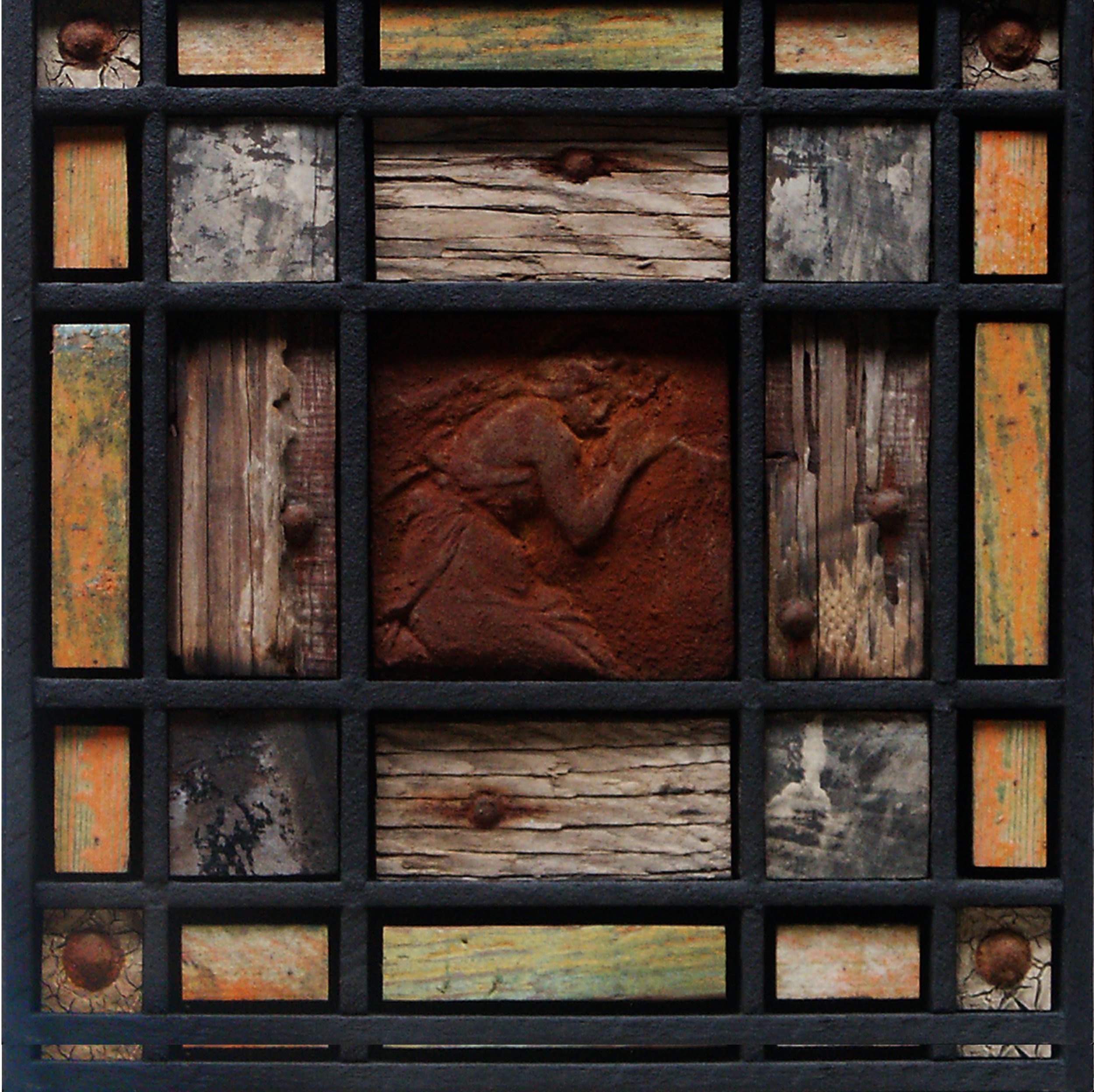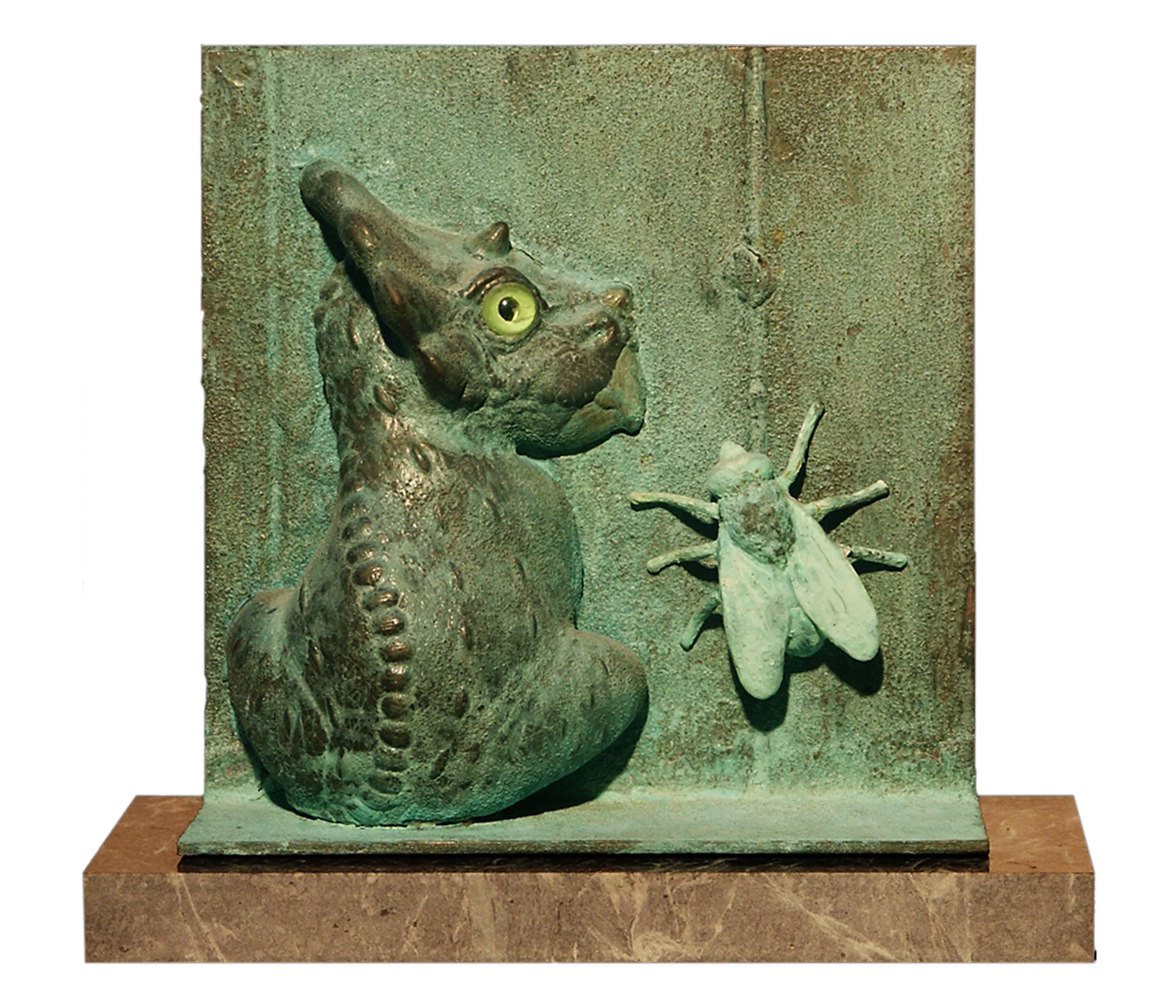Reflections on Mystery: Ron Robertson
by Halim Madi
A fitting prelude to Santa Barbara artist Ron Robertson’s body of art, is his website, where colors compete for attention while angels and samurais peek out of small squares and the four elements collide and combine. It’s hard to pick a link to click on. Choosing a path means foregoing others, just as Robertson’s body of work thwarts such singular paths.
In person, experiencing one of Robertson’s assemblages is akin to examining a cabinet of curiosities; the work invites conversation between very different objects. The word “assemble” finds its root in the Latin “simul,” which means “together,” and the artist’s oeuvre is a similar encouragement to consider the “togetherness” of what we perceive as disparate.
Ron Robertson, Title?
Robertson’s life is itself an illustration of how disparities can coalesce into a fascinating whole. For a decade, he studied printmaking and stone rubbing in Japan before returning to Santa Barbara to work as a commercial abalone diver. His artist statement holds that “the generalist, as opposed to the specialist, is able to perceive and live life more fully.”
Such ethos echoes Emily Dickinson’s seminal “I dwell in possibility,” in which the last two verses read: “The spreading wide my narrow Hands / To gather Paradise.” Within his studio, Robertson is gathering paradises for us to witness.
Robertson’s assemblages are not a fisherman’s net casting. They are a diver’s silent, humble movement through the sea. His relationship with the ocean seems to have influenced more than the texture of his pieces. His assemblages command attention the way something larger than oneself does.
During my first encounter with the work, my inner world was silenced for a moment. Facing Poseidon's Gem: Atlantis, suddenly, I was placed in a diving bell and told to look out and consider the largesse of a mystery I had grown estranged to. One can sense, through the rusty texture, Robertson’s intimate knowledge of the ocean’s powers.
Ron Robertson, The Dragon
In Penelope, the rusty female figure in the middle of the assemblage surrounded by two moats of found flotsam, further recalls the sea’s ravages. Here, Robertson turns Penelope’s dreading of Odysseus dying at sea into an emotionally charged barrage.
Robertson’s relationship to art is inseparable from matter and medium. His choice of oil, sculpture or physical objects has as much to do with what’s communicated as the subject matter at hand, and his use of medium is not an injunction. Rather, it’s a conversation, wherein matter is given room to express what it wants. He explores the voice of materiality best in a series of paintings titled Paper & Rocks.
Wrapped among one another, sturdy rock gains a sense of malleability and dances in the paper’s arms like a metaphor for the transformative potential of embracing what is different from oneself.
Part of me wanted the pieces to be larger, wall-sized, overpoweringly immersive – most of his pieces are around 20 x 20 inches. But as I grew more familiar with the work, I realized it couldn’t, nor should be otherwise. Robertson’s artistic sensibility was shaped by a decade spent in Japan, where cultural history honors the atemporality of existence. Hundreds of hours spent underwater, too, have no doubt altered the nature of his attention. His work, and the size of his pieces, are a reminder that portals to wonder can be very small indeed. That, if we listen and look carefully enough, worlds can unfold where we stand.
Themes recur in the work like Jungian archetypes. The dragon, the angel, Eve, the rocket, the Samurai. Shapes repeat like a litany to materiality. The cross, the shrine, the porthole. By revisiting each repeatedly, Robertson operates the visual equivalent of Roland Barthes’ semiological breakdown of our common mythology. What is a shrine when it hosts a broken disk with “love” written on it, as in the assemblage Love Is… What is a dragon when it’s portrayed with a fly half its size next to it, as in Dragon/Fly? What is a cross when Robertson frames two pieces of wood his grandchildren assemble?
One can see the impact of semiology on his work in This Is a Star – a subversive take on René Magritte’s This Is Not a Pipe. In Fallen Star, he expands on the 10-sided shape we associate with a star, rather than the burning globes in space. He draws a yellow “star” floating on ocean waters, like a symbol lost at sea. Again and again, Robertson seems to reappropriate everyday symbols to question established perceptions.
Similarly, the way Robertson turns the shrine into a new medium of expression or the porthole into a new canvas, infuses new meaning into objects made stale by cultural regimens. Like a tinkerer, he tests these objects’ ability to hold new purpose. He examines their resistance as symbols, expands their potential and bends their limits as cultural signifiers. In The War Machine/The Rainbow Machine, a slot-machine sculpture shows a face of destruction on one side and a playful arrangement with all seven colors of the rainbow on the other – a consummate tinkering between the dualities of our humanity.
Robertson contemplates reality with the discerning eye of a generalist who embraces complexities. At times, the lucidity he’s developed turns him into a historian of the future. On his Space Flotsam, he comments, “Like beach combing, space combing may be a form of recreation in the future.” Likewise, in the collection Relics, his comment on the piece Keys reads, “In the future, keys will be archaeological relics.” Pieces like these hold a prescience and beget a reflection beyond our individual existence.
Robertson’s aesthetic sensitivity has transformed over the years. The warmth of colors and the wisdom of his object placement is the culmination of his sensibilities and mastery. His journey on this planet, through its different bodies and continents, its histories and art periods, and into his and our collective psyches, is one thoughtful dive into the questions and tensions that shape our lives.
This year, Robertson and his family have set out to donate his vast body of work to community organizations, including Santa Barbara Arts Fund, SBCAW, Santa Barbara City College, Westmont College, Santa Barbara High School, Pacific Pride Foundation, Sarah House and Vita Art Center.







